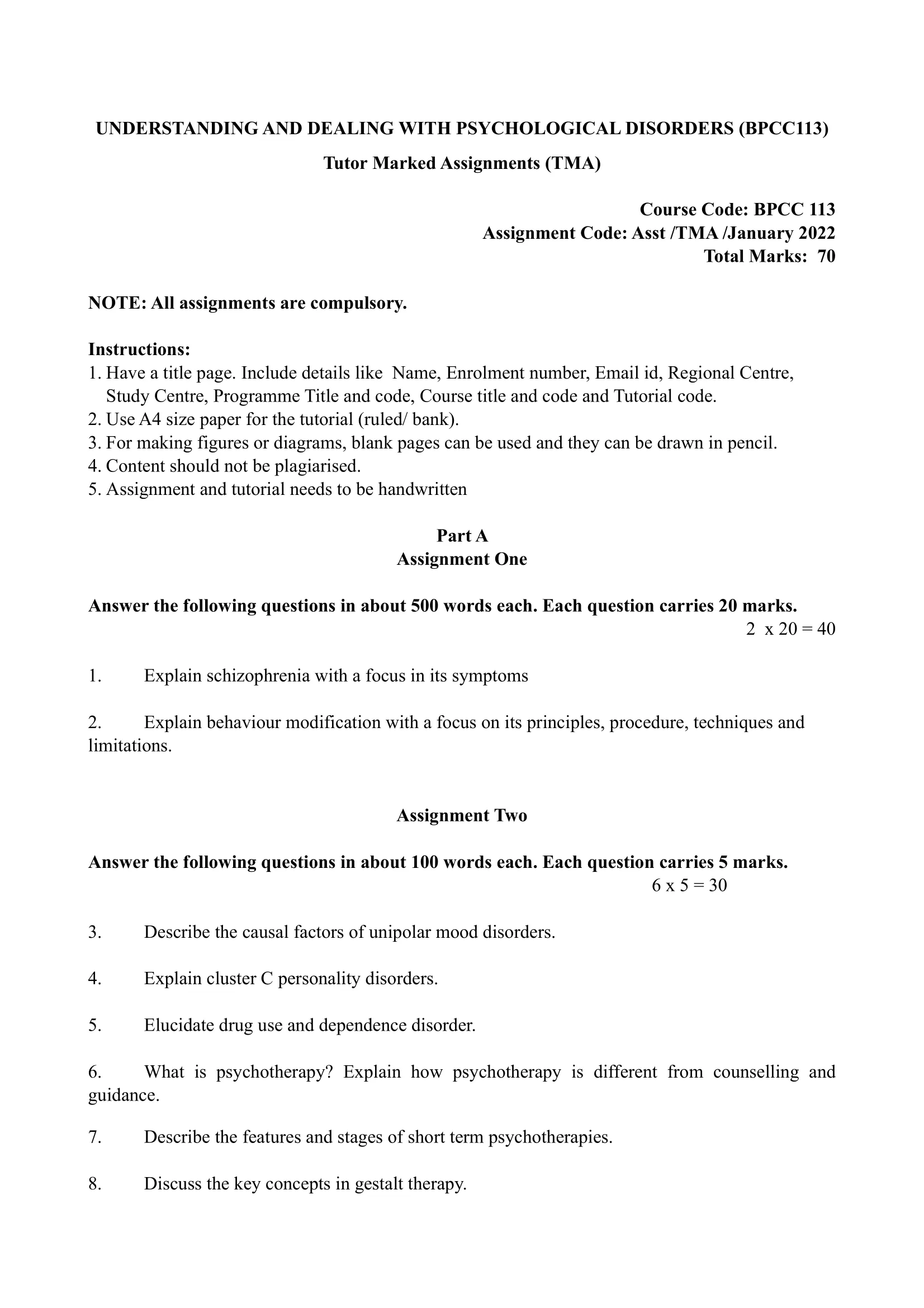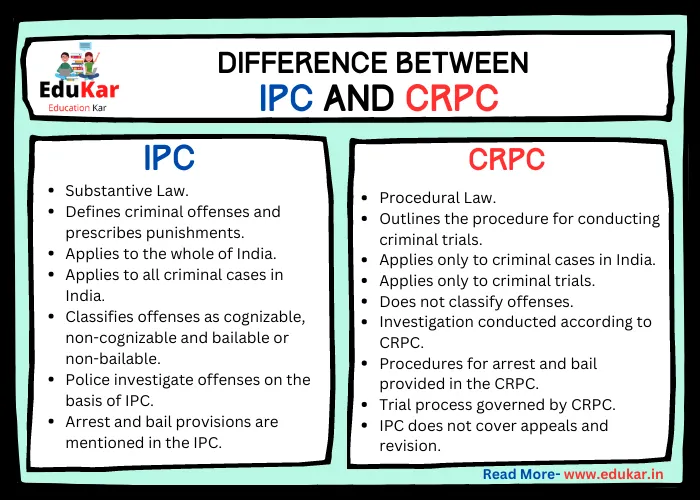Contents
- 1 Assignment One
- 2 Answer the following questions in about 500 words each. Each question carries 20 marks.
- 3 1. Explain schizophrenia with a focus in its symptoms.
- 4 2. Explain behaviour modification with a focus on its principles, procedure, techniques and limitations.
- 5 Assignment Two
- 6 Answer the following questions in about 100 words each. Each question carries 5 marks.
- 7 3. Describe the causal factors of unipolar mood disorders.
- 8 4. Explain cluster C personality disorders.
- 9 5. Elucidate drug use and dependence disorder.
- 10 6. What is psychotherapy? Explain how psychotherapy is different from counselling and guidance.
- 11 7. Describe the features and stages of short term psychotherapies.
- 12 5. Discuss the key concepts in gestalt therapy.

| Title | BPCC-113: IGNOU BAG Solved Assignment 2022-2023 |
| University | IGNOU |
| Degree | Bachelor Degree Programme |
| Course Code | BPCC-113 |
| Course Name | UNDERSTANDING AND DEALING WITH PSYCHOLOGICAL DISORDERS |
| Programme Name | Bachelor of Arts (General) |
| Programme Code | BAG |
| Total Marks | 100 |
| Year | 2022-2023 |
| Language | English |
| Assignment Code | Asst /TMA /January 2022 |
| Assignment PDF | Click Here |
| Last Date for Submission of Assignment: | For June Examination: 31st April For December Examination: 30th September |

Assignment One
Answer the following questions in about 500 words each. Each question carries 20 marks.
1. Explain schizophrenia with a focus in its symptoms.
Ans: Schizophrenia is a chronic and severe mental illness that affects how a person thinks, feels, and behaves. The disorder typically begins in the late teenage years or early adulthood and can persist throughout a person’s lifetime. Schizophrenia is characterized by a range of symptoms, including positive symptoms, negative symptoms, and cognitive symptoms. In this answer, we will focus on the symptoms of schizophrenia.
Positive Symptoms: Positive symptoms are symptoms that are present in people with schizophrenia but are not present in the general population. They are called “positive” because they involve an excess or distortion of normal mental functions. The most common positive symptoms of schizophrenia include:
- Hallucinations: These are false sensory perceptions that occur in the absence of external stimuli. For example, a person with schizophrenia may hear voices, see things that aren’t there, or feel things that aren’t real.
- Delusions: These are false beliefs that are not based in reality. They can take many forms, such as a belief that someone is out to get you, or that you have a special relationship with a famous person.
- Disorganized thinking and speech: This can manifest as jumbled or illogical thoughts and difficulty communicating those thoughts in a coherent manner.
- Abnormal motor behavior: This can include unusual postures or movements, such as repetitive or purposeless movements.
Negative Symptoms: Negative symptoms are symptoms that are not present in people with schizophrenia but are present in the general population. They are called “negative” because they involve a loss of normal mental functions. The most common negative symptoms of schizophrenia include:
- Apathy: This is a lack of interest or enthusiasm, which can manifest as a reduced ability to experience pleasure.
- Social withdrawal: This is a reduction in social interaction, which can lead to a lack of interest in social activities and relationships.
- Anhedonia: This is an inability to experience pleasure from activities that are normally enjoyable.
- Lack of motivation: This can manifest as a lack of energy or a lack of interest in participating in activities.
Cognitive Symptoms: Cognitive symptoms are symptoms that affect a person’s ability to think, learn, and remember. The most common cognitive symptoms of schizophrenia include:
- Difficulty with attention: This can manifest as difficulty focusing on tasks or sustaining attention over a period of time.
- Problems with working memory: This can manifest as difficulty holding information in memory for short periods of time.
- Impaired executive function: This can manifest as difficulty with planning, organizing, and completing tasks.
- Impaired decision-making: This can manifest as difficulty making decisions or making decisions that are in one’s best interest.
2. Explain behaviour modification with a focus on its principles, procedure, techniques and limitations.
Ans: Behavior modification is a psychological approach that involves altering an individual’s behavior through the application of behavioral principles and techniques. It is based on the principles of behaviorism, which suggest that behavior is learned through environmental cues and consequences, and that behavior can be modified through the use of positive and negative reinforcement.
Principles of Behavior Modification:
- Positive reinforcement: This involves providing a reward or positive consequence for a desired behavior, which increases the likelihood that the behavior will be repeated.
- Negative reinforcement: This involves removing an aversive stimulus when a desired behavior occurs, which increases the likelihood that the behavior will be repeated.
- Extinction: This involves removing the reinforcement for an undesired behavior, which decreases the likelihood that the behavior will be repeated.
- Punishment: This involves providing an aversive consequence for an undesired behavior, which decreases the likelihood that the behavior will be repeated.
Procedure of Behavior Modification: The procedure for behavior modification typically involves several steps:
- Identify the target behavior: The first step is to identify the behavior that needs to be changed.
- Define the behavior: The behavior is defined in specific, observable terms so that it can be measured.
- Collect baseline data: Data is collected to determine the frequency and duration of the target behavior.
- Develop a treatment plan: A treatment plan is developed based on the principles of behavior modification. The plan includes specific goals, reinforcement schedules, and consequences for both desired and undesired behavior.
- Implement the plan: The plan is put into action, and the individual’s behavior is monitored and recorded.
- Evaluate the plan: The effectiveness of the plan is evaluated based on changes in the frequency and duration of the target behavior.
Techniques of Behavior Modification: There are several techniques that are commonly used in behavior modification, including:
- Token economy: This involves giving tokens or points for desired behaviors, which can be exchanged for rewards.
- Contingency contracting: This involves setting up a contract between the individual and the therapist, in which rewards and consequences are clearly defined.
- Self-monitoring: This involves teaching the individual to monitor and record their own behavior.
- Time-out: This involves removing the individual from a situation that is reinforcing the undesired behavior.
Limitations of Behavior Modification: While behavior modification can be an effective approach for changing behavior, there are some limitations to its use. These include:
- Limited applicability: Behavior modification may not be effective for more complex behaviors, such as those that are the result of underlying psychological or emotional issues.
- Ethical concerns: There may be ethical concerns related to the use of punishment or aversive techniques in behavior modification.
- Limited generalization: The effects of behavior modification may not generalize to other settings or situations.
- Resistance to change: Individuals may resist changing their behavior, even in the face of rewards or consequences.
Assignment Two
Answer the following questions in about 100 words each. Each question carries 5 marks.
3. Describe the causal factors of unipolar mood disorders.
Ans: Unipolar mood disorders, also known as major depressive disorder, are complex conditions that can be caused by multiple factors. The most commonly recognized causal factors include biological, psychological, and social factors. Biological factors include genetics, chemical imbalances in the brain, and changes in hormonal levels. Psychological factors, such as negative thinking patterns, low self-esteem, and stress, can also contribute to the development of unipolar mood disorders. Social factors, such as environmental stressors, trauma, and social isolation, can also play a role. It is important to note that while these factors can increase the risk of developing unipolar mood disorders, not everyone who experiences them will develop the disorder. Additionally, other factors, such as a history of trauma, substance abuse, or other mental health conditions, may also increase the risk of developing unipolar mood disorders.
4. Explain cluster C personality disorders.
Ans: Cluster C personality disorders are a group of personality disorders characterized by anxious and fearful behavior. There are three types of Cluster C personality disorders: Avoidant Personality Disorder, Dependent Personality Disorder, and Obsessive-Compulsive Personality Disorder.
Individuals with Avoidant Personality Disorder experience intense anxiety and fear of rejection, leading them to avoid social situations and relationships. They may be excessively sensitive to criticism, have low self-esteem, and fear embarrassment or shame.
Individuals with Dependent Personality Disorder have a strong need to be taken care of and fear being alone. They may have difficulty making decisions, lack self-confidence, and have an excessive need to be reassured by others.
Individuals with Obsessive-Compulsive Personality Disorder have a preoccupation with perfectionism, orderliness, and control. They may be overly conscientious, inflexible, and rigid in their thinking and behavior, and have difficulty delegating tasks or trusting others to complete them.
5. Elucidate drug use and dependence disorder.
Ans: Drug use and dependence disorder, also known as substance use disorder, is a complex condition characterized by the persistent and problematic use of drugs or alcohol despite negative consequences. The disorder can range from mild to severe, and can affect an individual’s physical, psychological, and social functioning.
Drug use disorder is often caused by a combination of genetic, environmental, and psychological factors. Some people may be more vulnerable to developing the disorder due to a genetic predisposition, while environmental factors such as peer pressure, availability of drugs, and stress can also play a role. Psychological factors such as depression, anxiety, or trauma may also contribute to the development of the disorder.
Symptoms of drug use disorder can include intense cravings for the substance, loss of control over drug use, and continued use despite negative consequences such as relationship problems, legal issues, or health problems. Individuals with the disorder may also experience physical symptoms such as withdrawal symptoms, tolerance to the substance, and continued use despite physical harm.
Treatment for drug use disorder typically involves a combination of behavioral therapies, such as cognitive-behavioral therapy and contingency management, as well as medication-assisted treatments to manage withdrawal symptoms and cravings. Successful treatment typically involves a combination of multiple approaches, including ongoing support and counseling to address the underlying causes of the disorder.
6. What is psychotherapy? Explain how psychotherapy is different from counselling and guidance.
Ans: Psychotherapy is a type of mental health treatment that involves talking with a trained therapist to help individuals improve their mental health and well-being. Psychotherapy is based on the idea that our thoughts, feelings, and behaviors are interconnected and that by examining and understanding these connections, individuals can learn to manage their emotions and cope with life’s challenges.
Psychotherapy is different from counselling and guidance in several ways. Counselling is a type of mental health treatment that focuses on specific issues such as relationship problems, stress management, and grief. Guidance, on the other hand, is a type of support that is aimed at helping individuals make decisions or solve specific problems, such as career choices or financial planning.
Psychotherapy is generally a more comprehensive and in-depth treatment that is designed to help individuals address a wide range of mental health concerns, such as depression, anxiety, and trauma. Psychotherapy typically involves longer sessions than counselling or guidance, and may involve exploring issues from an individual’s past, examining patterns of behavior, and learning new coping skills.
Another key difference is the level of training required for psychotherapists compared to counsellors or guidance counselors. Psychotherapists generally have more extensive training in areas such as psychology, social work, or psychiatry, and may be licensed to provide a wider range of services than counsellors or guidance counselors.
7. Describe the features and stages of short term psychotherapies.
Ans: Short-term psychotherapies are a type of mental health treatment that are designed to provide symptom relief and improve functioning over a limited number of sessions. The specific features and stages of short-term psychotherapies may vary depending on the approach used, but there are some general principles that apply to many short-term psychotherapies.
Features of short-term psychotherapies include a focus on specific goals, a limited number of sessions (typically between 8 and 20), and a structured approach to treatment. The therapist and client work together to identify specific symptoms or problems to be addressed, and to set achievable goals for treatment. The therapist then works with the client to develop a plan for achieving these goals, using specific techniques and interventions to address the identified problems.
The stages of short-term psychotherapies can also vary depending on the approach used, but generally include:
- Assessment: The therapist and client work together to identify the client’s specific concerns and develop an understanding of the underlying issues.
- Goal setting: The therapist and client work together to identify specific goals for treatment, and develop a plan for achieving these goals.
- Intervention: The therapist uses specific techniques and interventions to address the identified problems and work towards achieving the goals of treatment.
- Termination: The therapist and client work together to review progress and determine whether the goals of treatment have been achieved. The therapist may also help the client develop a plan for maintaining progress after treatment has ended.
Some common short-term psychotherapies include cognitive-behavioral therapy, interpersonal therapy, and brief psychodynamic therapy. While these approaches have different theoretical foundations and techniques, they share a focus on achieving specific goals over a limited number of sessions. Short-term psychotherapies can be an effective treatment option for individuals with mild to moderate mental health concerns who are looking for a structured and time-limited approach to treatment.
5. Discuss the key concepts in gestalt therapy.
Ans: Gestalt therapy is a type of psychotherapy that emphasizes self-awareness and personal responsibility, with a focus on the present moment and the person’s experience of the world. The therapy was developed by Fritz Perls in the 1940s and 1950s, and it draws on elements of humanistic psychology, existential philosophy, and Eastern spiritual traditions. The key concepts in Gestalt therapy include the following:
- The Here and Now: Gestalt therapy focuses on the present moment and encourages clients to be fully present in their experience. This includes paying attention to thoughts, feelings, and physical sensations as they occur in the moment, rather than getting caught up in past or future concerns.
- Awareness: Gestalt therapy emphasizes self-awareness as a key component of personal growth and development. Clients are encouraged to become more aware of their thoughts, feelings, and behaviors, as well as their interactions with others and the world around them.
- Contact: Gestalt therapy emphasizes the importance of contact with the environment and with other people. This includes exploring the ways in which individuals make contact or avoid contact, and how they can improve their ability to connect with others in a more authentic and meaningful way.
- Responsibility: Gestalt therapy emphasizes personal responsibility, with the idea that individuals are ultimately responsible for their own thoughts, feelings, and behaviors. The therapist helps the client to take responsibility for their own growth and development, and to develop a greater sense of personal agency.
- The Gestalt Cycle of Experience: This cycle involves awareness, energy, action, and contact. Individuals become aware of a need, they generate energy to meet that need, they take action to meet the need, and they make contact with the environment and other people. The cycle then begins again with a new need.
- The Empty Chair Technique: This technique is a commonly used tool in Gestalt therapy, in which the client is asked to imagine another person or part of themselves in an empty chair, and to engage in a dialogue or role-playing exercise with that imaginary person or part of themselves.
How to Download BPCC-113 Solved Assignment?
You can download it from the www.edukar.in, they have a big database for all the IGNOU solved assignments.
Is the BPCC-113 Solved Assignment Free?
Yes this is absolutely free to download the solved assignment from www.edukar.in
What is the last submission date for BPCC-113 Solved Assignment?
For June Examination: 31st April, For December Examination: 30th October


![Best 5 Speech on Yoga [Long & Short] Speech-on-Yoga](https://edukar.in/wp-content/uploads/2023/03/Speech-on-Yoga.webp)





![Speech on Subhash Chandra Bose [Short & Long] Speech-on-Subhash-Chandra-Bose](https://edukar.in/wp-content/uploads/2023/03/Speech-on-Subhash-Chandra-Bose.webp)







